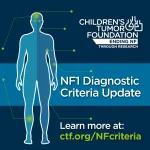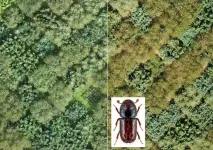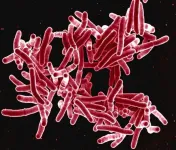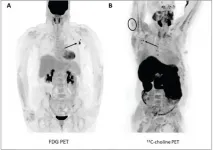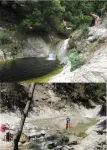(Press-News.org) Updated Criteria Also Released for Legius Syndrome and Mosaic NF
NF2 and Schwannomatosis Diagnostic Criteria to Be Released Later This Year
The Children's Tumor Foundation (CTF) today announced the publication of updated diagnostic criteria for the genetic disorder neurofibromatosis type 1 (NF1) in Genetics in Medicine, the official journal of the American College of Medical Genetics and Genomics. The new publication is the result of an extensive, multi-year collaborative effort of over 90 leading neurofibromatosis (NF) experts from around the globe, and is aimed at improving the accuracy and earlier diagnosis of NF1 in patients, thus ultimately leading to improved care and quality of life for those patients. Today's announcement is being made on the occasion of NF Awareness Month, a global awareness initiative focused on increasing recognition of all the forms of neurofibromatosis and schwannomatosis.
The original diagnostic criteria for NF1 and NF2 were established at the National Institutes of Health (NIH) consensus meeting in 1987, and the diagnostic criteria for schwannomatosis was established in 2005. Since that time, there has been an explosion of knowledge about these genetic disorders, including the discovery of the genes that cause NF1, NF2, and schwannomatosis, as well as the technological development of genetic testing. In recent years, NF clinicians have noted that an updated consensus was needed to better communicate (for both medical professionals and patients) the distinctions between NF1, NF2, and schwannomatosis, as patients were at times being misdiagnosed or receiving delayed diagnosis and care.
As a result, in 2017 a group of NF investigators reached out to the Children's Tumor Foundation, the largest nongovernmental funder of all forms of NF research in the world, to sponsor a review and potential revision of the NF diagnostic criteria. That group of investigators grew into a worldwide effort that utilized the following guiding principles in the development of the updated criteria:
Formulate a clear delineation between NF1, NF2, and schwannomatosis criteria
* Represent the best consensus among NF experts
* Reflect input from patients, caregivers, families, foundations, and advocacy groups
* Exclusively address the issues of diagnosis (rather than clinical management)
* Be broadly representative of medical specialties
* Be usable by general doctors as well as NF specialists
* Recognize advances in genetics without requiring genetic analysis for diagnosis
* Be relevant in different countries and health care systems, now and in coming years
While the review of all forms of NF were conducted concurrently by the expert groups, it is the updated NF1, Legius syndrome, and mosaic NF criteria that are available at this time, with the NF2 and schwannomatosis criteria release to come later this year.
The results of today's update are now publicly available in the publication Genetics in Medicine, in an article entitled "Revised Diagnostic Criteria for Neurofibromatosis Type 1 and Legius Syndrome: An International Consensus Recommendation". The article can be found at https://www.nature.com/articles/s41436-021-01170-5. All the names of the participants in the International Consensus Group on Neurofibromatosis Diagnostic Criteria can be found in the paper.
In the article, the authors outline the following:
Purpose: by incorporating major developments in genetics, ophthalmology, dermatology, and neuroimaging, to revise the diagnostic criteria for neurofibromatosis type 1 (NF1) and to establish diagnostic criteria for Legius syndrome (LGSS).
Methods: using a multistep process, beginning with a Delphi method involving global experts and subsequently involving non-NF experts, patients, and foundations/patient advocacy groups.
Results: reached consensus on the minimal clinical and genetic criteria for diagnosing and differentiating NF1 and LGSS, which have phenotypic overlap in young patients with pigmentary findings. Criteria for the mosaic forms of these conditions are also provided.
Conclusion: the revised criteria for NF1 incorporate new clinical features and genetic testing, whereas the criteria for LGSS were created to differentiate the two conditions. It is likely that continued refinement of these new criteria will be necessary as investigators (1) study the diagnostic properties of the revised criteria, (2) reconsider criteria not included in this process, and (3) identify new clinical and other features of NF and related disorders.
In coming months, the Clinical Care Advisory Board of the Children's Tumor Foundation, in partnership with NF clinics, medical groups, and other NF organizations, will roll out a multi-format education program of the updated criteria for both general physicians and NF experts, to increase knowledge and advance care of the various forms of neurofibromatosis.
INFORMATION:
NF, short for neurofibromatosis, is a group of rare genetic disorders that cause tumors to grow on nerves throughout the body, includes three distinct forms (NF1, NF2, or schwannomatosis), and affects all ethnicities, races, and genders equally. In addition to tumors growing anywhere in the body, NF can lead to blindness, deafness, bone abnormalities, disfigurement, learning disabilities, disabling pain, and cancer. NF affects 1 in 3,000 births, and while the FDA in 2020 approved the first-ever treatment for NF1, Koselugo (selumetinib) for inoperable plexiform neurofibromas, there is no cure at this time for NF, which is why it is crucial to improve diagnosis, and ultimately, medical care, treatment, and research for the over 2.5 million people worldwide living with NF.
Driving the goal for increased awareness and funding for NF is the Children's Tumor Foundation's global awareness campaign, called Make NF Visible. This multi-format activation was launched in May, for NF Awareness Month, a dedicated time each year that brings attention to the inspirational and extraordinary stories of those living with NF, and the critical need for research to better their lives. Learn more about the Make NF Visible campaign at makenfvisible.org.
On the occasion of NF Awareness Month (May) and the publication of the updated diagnostic criteria, the Children's Tumor Foundation has also created an online patient-focused site which will host updated patient brochures, webinar links, and other important tools including upcoming phone apps, that will contain information to be shared with patients, caregivers, families, educators, researchers, and clinicians. New resources, links to publications, news (including the announcement of NF2 and schwannomatosis criteria) will be posted throughout the year at ctf.org/nfcriteria.
To learn more about the Children's Tumor Foundation and Children's Tumor Foundation Europe, including research priorities, patient programs, community initiatives, and more, visit ctf.org and ctfeurope.org.
Open up Scott Roy's Twitter bio and you'll see a simple but revealing sentence: "The more I learn the more I'm confused." Now the rest of the scientific world can share in his confusion. The San Francisco State University associate professor of Biology's most recent research, published earlier this month in one of the scientific world's most prestigious journals, catalogues a strange and confounding system of genes in a tiny rodent that scientists have ignored for decades.
"This is basically the weirdest sex chromosome system known to science," Roy said. "Nobody ordered this." But he's serving it anyway.
The owner of those chromosomes is the creeping vole, a burrowing rodent native to the Pacific Northwest. Scientists ...
In recent years, foresters have been able to observe it up close: First, prolonged drought weakens the trees, then bark beetles and other pests attack. While healthy trees keep the invaders away with resin, stressed ones are virtually defenseless. Freiburg scientist Sylvie Berthelot and her team of researchers from the Faculty of Environment and Natural Resources and the Faculty of Biology are studying the importance of tree diversity on bark beetle infestation. They are investigating whether the composition of tree species affects bark beetle feeding behavior. The team recently published their findings in the Journal of Ecology.
In a 1.1 hectare experimental set-up in Freiburg, six native deciduous and coniferous tree species from Europe and six deciduous and coniferous ...
SAN ANTONIO (May 19, 2021) -- Four months of multi-drug therapy that included rifapentine and moxifloxacin treated active tuberculosis (TB) as effectively as the standard six-month regimen in a multinational study, cutting treatment time by a third. Coauthors including Marc Weiner, MD, of The University of Texas Health Science Center at San Antonio, reported the findings May 6 in the New England Journal of Medicine.
"Shorter treatment would be easier for people to complete without missing doses, and ultimately may be cost-effective," said Dr. Weiner, associate professor in the health science center's Joe R. and Teresa Lozano END ...
A team of researchers at the Centre Spatial de Liège (CSL) of the University of Liège has just developed a method to identify the contributors and origins of stray light on space telescopes. This is a major advance in the field of space engineering that will help in the acquisition of even finer space images and the development of increasingly efficient space instruments. This study has just been published in the journal Scientific Reports.
Space telescopes are becoming more and more powerful. Technological developments in recent years have made it possible, for example, to observe objects further and further into the universe or to measure the composition of the Earth's atmosphere with ever greater precision. However, there is still one factor limiting the performance ...
HAMILTON, ON (May 19, 2021) - Researchers have found that the inclusion of a third drug to commonly used dual-drug inhalers can reduce asthma exacerbations and improve control over the disease in children, adolescents, and adults with moderate-to-severe asthma.
A team from McMaster University and The Research Institute of St. Joe's Hamilton announced their findings from a systematic review and meta-analysis. Data from 20 randomized controlled trials, which included a total of almost 12,000 patients, were analyzed in the study.
Dual-drug inhalers used to treat asthma typically contain an inhaled corticosteroid (ICS) to reduce inflammation, as well as a long-acting beta-adrenoceptor agonist (LABA) that acts as a bronchodilator. High-certainty evidence showed that the inclusion of a third ...
Leesburg, VA, May 19, 2021--According to an open-access article in ARRS' American Journal of Roentgenology (AJR), increased axillary lymph node or ipsilateral deltoid uptake is occasionally observed on FDG or 11C-choline PET performed after Pfizer-BioNTech or Moderna COVID-19 vaccination.
"Recognition of occasional abnormal axillary lymph node or deltoid uptake on PET examinations performed after COVID-19 vaccination will aid interpreting physicians and reduce unnecessary biopsies," wrote corresponding author Jason R. Young from the department of radiology at Mayo Clinic in Rochester, MN.
Young and colleagues' retrospective study included ...
For the first time, geological records have been used to reconstruct the history of Larsen C Ice Shelf in Antarctica. The ice shelf is the largest remaining remnant of a much more extensive area of ice on the Antarctic Peninsula that began to break up during the 1990s (Larsen A), and saw a huge collapse in 2002 (Larsen B). This new reconstruction enables scientists to better understand if and when the remaining ice shelf could collapse in the future.
Publishing this month in the journal Geology an international team describes how the largest remaining ice shelf on the Antarctic ...
By mapping its genetic underpinnings, researchers at University of California San Diego School of Medicine have identified a predictive causal role for specific cell types in type 1 diabetes, a condition that affects more than 1.6 million Americans.
The findings are published in the May 19, 2021 online issue of Nature.
Type 1 diabetes is a complex autoimmune disease characterized by the impairment and loss of insulin-producing pancreatic beta cells and subsequent hyperglycemia (high blood sugar), which is damaging to the body and can cause other serious health problems, such as heart disease and vision loss. Type 1 is less common than type 2 diabetes, but its prevalence is growing. The U.S. Centers for Disease ...
Boulder, Colo., USA: Deep pools below waterfalls are popular recreational swimming spots, but sometimes they can be partially or completely filled with sediment. New research showed how and why pools at the base of waterfalls, known as plunge pools, go through natural cycles of sediment fill and evacuation. Beyond impacting your favorite swimming hole, plunge pools also serve important ecologic and geologic functions. Deep pools are refuges for fish and other aquatic animals in summer months when water temperatures in shallow rivers can reach lethal levels. Waterfalls also can liquefy sediment within the pool, potentially triggering debris flows that can damage property and threaten ...
Florida State University researchers have more insight into a strange sea creature found in oceans around the world and what their presence means for the health of a marine ecosystem.
Scientists have thought that salps -- small marine organisms that look like clear, gelatinous blobs -- competed for resources with krill, shrimp-like creatures that are an important food source for many marine animals. But new research published in Limnology and Oceanography suggests that salps are actually competing for food with an organism known as a protist.
An image of a salp taken during research. New research published in Limnology and Oceanography suggests that salps are actually competing for food with an organism known as a protist. (Courtesy of ...
